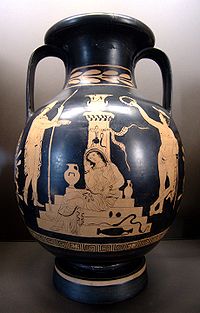
Lucanian vase painting
Encyclopedia


Lucania
Lucania was an ancient district of southern Italy, extending from the Tyrrhenian Sea to the Gulf of Taranto. To the north it adjoined Campania, Samnium and Apulia, and to the south it was separated by a narrow isthmus from the district of Bruttium...
between 450 and 325 BC. It was the oldest South Italian regional style. Together with Sicilian and Paestan vase painting
Paestan vase painting
Paestan vase painting was a style of vase painting associated with Paestum, a Campanian city in Italy founded by Greek colonists. Paestan vase painting is one of five regional styles of South Italian red-figure vase painting.-Development:...
, it formed a close stylistic community.
The Lucania
Lucania
Lucania was an ancient district of southern Italy, extending from the Tyrrhenian Sea to the Gulf of Taranto. To the north it adjoined Campania, Samnium and Apulia, and to the south it was separated by a narrow isthmus from the district of Bruttium...
n vase painting tradition began around 430 BC, with the works of the Pisticci Painter
Pisticci Painter
The “Pisticci Painter” was a vase painter who lived in the second half of the V century B.C., thus called because much of his artistic works were discovered in Pisticci, a small town few miles away from Metaponto, Basilicata, Italy....
. He was probably active in Pisticci
Pisticci
Pisticci is a town comune in the province of Matera, in the Southern Italian region of Basilicata....
, where some of his works were discovered. He was strongly influenced by Attic tradition. His works rarely depict mythological scenes, probably reflecting the local tastes. Most of them were made as grave offerings. Other early production centres were at Policoro
Policoro
Policoro is a town and comune in the province of Matera, in the Southern Italian region of Basilicata. It is bounded by the communes of Rotondella, Scanzano Jonico and Tursi. Policoro is a relatively small town of approximately 15,000 inhabitants...
and Metapontum
Metapontum
Metapontum, Metapontium or Metapontion , was an important city of Magna Graecia, situated on the gulf of Tarentum, between the river Bradanus and the Casuentus . It was distant about 20 km from Heraclea and 40 from Tarentum...
. The Pisticci Painter's successors, the Amykos Painter and the Cyclops Painter had a workshop in Metapontum
Metapontum
Metapontum, Metapontium or Metapontion , was an important city of Magna Graecia, situated on the gulf of Tarentum, between the river Bradanus and the Casuentus . It was distant about 20 km from Heraclea and 40 from Tarentum...
. In 1973, archaeologists were able to prove the existence of such a workshop, by discovering a pottery kiln associated with fragments of vases by the Amykos Painter, the Kreusa Painter and the Dolon Painter. They were the first to paint the new nestoris (see Typology of Greek Vase Shapes
Typology of Greek Vase Shapes
Pottery in Greece has a long history and the form of Greek Vase Shapes has had a continuous evolution from the Minoan period down to the Hellenistic era...
) vase type. Large quantities of Lucanian vases were exported to Apulia
Apulia
Apulia is a region in Southern Italy bordering the Adriatic Sea in the east, the Ionian Sea to the southeast, and the Strait of Òtranto and Gulf of Taranto in the south. Its most southern portion, known as Salento peninsula, forms a high heel on the "boot" of Italy. The region comprises , and...
. The Dolon Painter may have emigrated there during his career, as his late work reflects an influence by the Apulian Tarporley Painter
Tarporley Painter
The Tarporley Painter was an Apulian red-figure vase painter. His works date to the first quarter of the 4th century BC. The Tarporley Painter is his period's most important representative of the so-called "Plain Style"...
. Around 370 BC, the workshops in Policoro and Metapontum ceased to function, and production moved to the hinterland. After the mid-4th century, the quality of Lucanian vases deteriorated increasingly, and the range of painted motifs became more and more monotonous. Exports to Apulia also stopped nearly entirely. Around 325 BC, production ceased; the last important representatives of Lucanian vase painting were the Primato Painter (strongly influenced by the Apulian Lycourgos Painter) and the Roccanova Painter. A total of about 1,500 Lucanian vases survive.
In terms of motifs, mythological or theatrical scenes are common. For example, the Cheophoroi painter, named after the Cheophoroi
Orestia
Orestia may refer to:* Orestis ancient region of Epirotic Macedonia.* The old name for Edirne* The Oresteia* Orestia , a genus of flea beetles...
by Aeschylos showed scenes from the tragedy in question on several of his vases. The influence of Apulian vase painting becomes tangible roughly at the same time. Especially polychromy and vegetal decor became standard.

